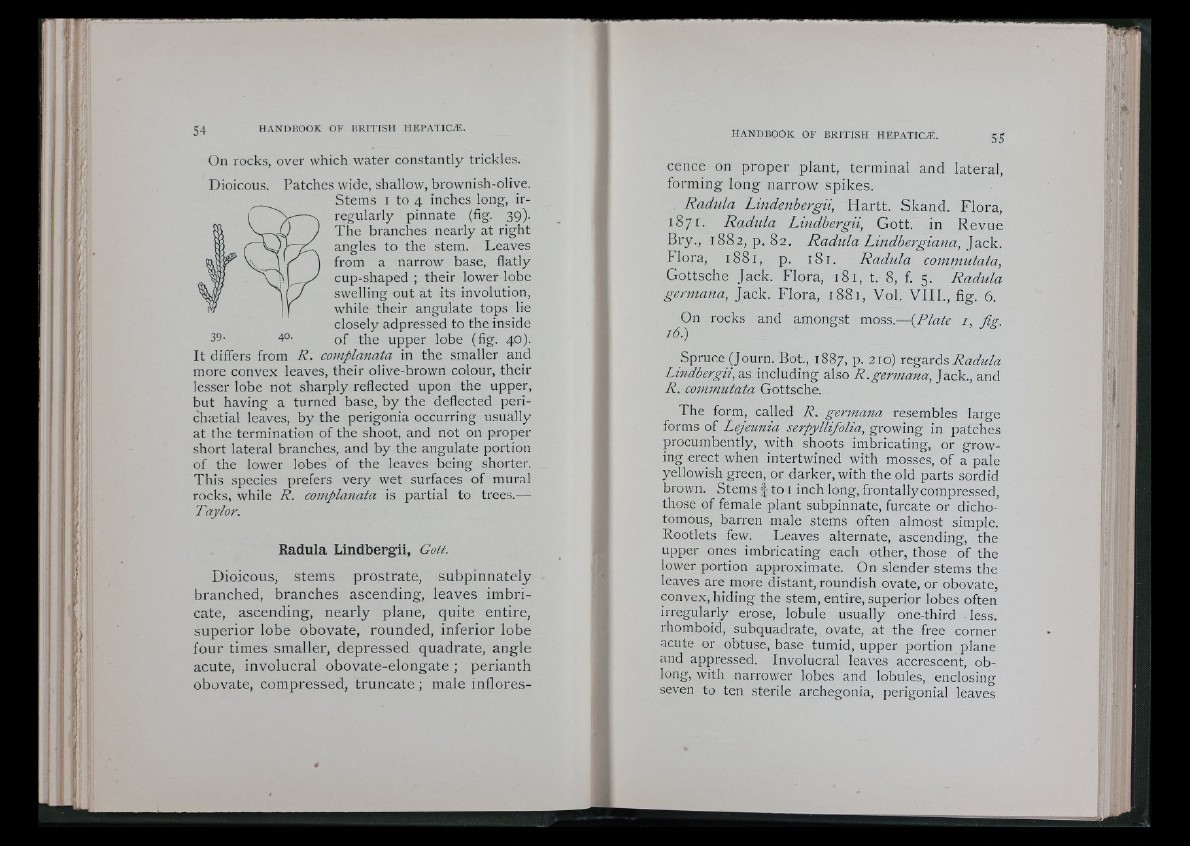
i
On rocks, over which water constantly trickles.
Dioicous. Patches wide, shallow, brownish-olive.
Stems I to 4 inches long, irregularly
pinnate (fig. 39).
The branches nearly at right
angles to the stem. Leaves
from a narrow base, flatly
cup-shaped ; their lower lobe
swelling out at its involution,
while their angulate tops lie
closely adpressed to the inside
39- 40. of the upper lobe (fig. 40).
It differs from R . eomplanata in the smaller and
more convex leaves, their olive-brown colour, their
lesser lobe not sharply reflected upon the upper,
but having a turned base, by the deflected peri-
chætial leaves, by the perigonia occurring usually
at the termination of the shoot, and not on proper
short lateral branches, and by the angulate portion
of the lower lobes of the leaves being shorter.
This species prefers very wet surfaces of mural
rocks, while R. eomplanata is partial to trees.—
Taylor.
Radula Lindbergii, Gott.
Dioicous, stemm prostrate, subpinnately
branched, branches ascending, leaves imbricate,
ascending, near ly plane, quite entire,
super ior lobe obovate, rounded, inferior lobe
four times smaller, depres sed quadrate, angle
acute, involucral obovate-eiongate ; perianth
obovate, compressed, truncate ; male inflores•
ft
cence on proper plant, terminal and lateral,
forming long nar row spikes.
Radula Ltndenbergii, Hartt. Skand. Flora,
1871. Radula Lindbergii, Gott. in Re vu e
Bry., 1882, p. 82, Radula Lindbergiana, Jack,
klora, 18 8 1, p. 181. Radida commutata,
Got tsche Jack. Flora, 181, t. 8, f. 5. Radula
gennana, Jack. Flora, 1881, Vol. VI I I . , fig. 6.
On rocks and amongst moss.— {Plate i , fig.
16.)
Spruce (Journ. Bot , 1887, p. 210) regards
Lindbergii,-3,s including also R.germana, Jack., and
R. commutata Gottsche.
The form, called R. germana resembles large
forms of Lejeunia serpyllijolia, growing in patches
procumbently, with shoots imlDricating, or growing
erect when intertwined with mosses, of a pale
yellowish green, or darker, with the old parts sordid
brown. Stems | to i inch long, frontallycompressed,
those of female plant subpinnate, furcate or dichotomous,
barren m.ale stems often almost simple.
Rootlets few. Leaves alternate, ascending, the
upper ones imbricating each other, those of the
lower portion approximate. On slender stems the
leaves are more distant, roundish ovate, or obovate,
convex, hiding the stem, entire, superior lobes often
irregularly erose, lobule usually one-third less,
rhomboid, subquadrate, ovate, at the free corner
acute or obtuse, base tumid, upper portion plane
and appressed. Involucral leaves accrescent, oblong,
with narrower lobes and lobules, enclosing
seven to ten sterile archegonia, perigonial leaves